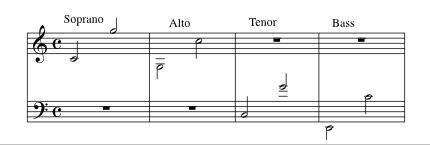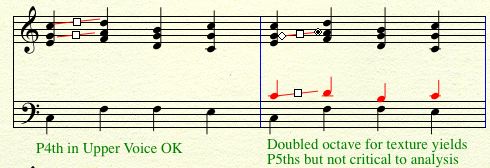Last class we began our study of Species counterpoint. The ultimate result of fluid species counterpoint studies is a keen understanding of how melodic lines interact with one another. At the end of our examination of all 5 species counterpoint, you will be thoroughly versed in writing 4 part textures. However, for our study of analysis, we will now take a more broad overview of four part writing.
Homework: Workbook all of Chapter 5 except pages 39#2
Chord Construction
1. Four Part textures
a. In our study of harmony we will be working in a chorale, or vocal style. This style of music most easily reduces a given piece of music to its most basic elements and therefore provides the quickest and easiest way to understand a piece of music.
2. Vocal Range
a. In writing chorale style we will be focusing on just four independent lines or "voices" These are the same as would be found in a typical choir: Soprano, Alto, Tenor and Bass and have the following ranges.

3. Doubling
a. When writing simple triads in a 4 voice texture, you are forced to double at least one note.
1. Tendancy to doulbe most stable part so 8vas, 5ths and 3rds are most common.
2. Never double the leading tone.
4. Complete and Incomplete Chords (See example 5-5 H&VL)
a. Best is to have all triad tones present in chord
b. OK to omit 5th: The ear assumes it is there
c. When the 5th is omitted, 3X root is preferable to 2X 3rd.
d. When the 5th is omitted, in a 7th chord, the root is doubled
5. Spcaing
a. Adjacent upper voices must be within an octave of one another
b. Tenor can be up to 15ma from Bass
6. Open Vs. Clse Position
When writing chorale style, the distribution and spacing of voices is crucial. In general, we have two types of spaicing or "voice positions". In most contexts, the positions can be used independently or together.
a. Close position= 3 upper voices as close as possible and there is no room to insert chord tones
b. Open Position= Chord tones may be inserted between voices

7. Keyboard Style
a. An alternate and often used presentation of 4 voice writing is "keyboard style" where the distance between the tenor and soprano voices fits within the right hand of a keyboard player. This style may often result in voices which are out of the vocal ranges we have defined above. Our focus will be on chorale style.
8&9. Soprano and unusual spacing.
a. H&VL makes suitable mention that the soprano voice on 1 of a triad yields a stable, if not static impression as a result of its octave relationship with the bass. It also mentions the 3rd in the soprano as being particularly sonorous. As always, remember that our presentation is vexed in very general terms and exceptions to the rules we learn exist. This is also true with spacing where compositional, orchestrational, or textural factors may necessitate deviations. In our studies, any exceptions to the above rules will be temporary and for purposes of study, we will always try to conform to the rules as general guidelines.
Voice Leading
We have now arrived at one of the most critical junctures of formal music training: Voice Leading. To be sure, long before there was any understanding of chords and triads, there were individual melodic lines that, when sounded simultaneously, yielded sonorities we now call chords and triads. As well, contemporary compositional techniques have presented tools that, once again away from choradal and traidic structures. Our study of voice leading will follow the rules of species counterpoint as presented in webnotes 6a. Whereas H&VL does not contradict these notes, H&VL presents only an overview of species counterpoint. However, in order to best understand both counterpoint and chorale style harmonic analysis I have deffered the presentation of certain H&VL topics to webnotes 6a. Please be sure to fully understand the remaining notes presented below.
10., 11, & 12 Meloic Motion, Leaps, and Simultaneous motion: See webnotes 6a
13. Forbidden Parallel motion (see H&VL ex. 5-17-5-22)
a. In webnotes 6a we learned that 1st species counterpoint dictates that parallel unis, 8va, & 5ths are forbidden as such writing diminishes the independence of the melodic lines. This rule remains true in 4 voices and such parallelisms may not exist in succession within the same voices.
b. Of special note is the movement from a Perfect 5th to a Dim. 5th as it will result in a suitable resolution of the dim 5th
c. Movement from a dim 5th to a P5th however, does not allow for resolution of the dim 5th and is therefore discouraged.
d. Parallel P4th in 4 voice writing is acceptable when the parallelism exists in the upper voices.
14. Doublings in free textures (see H&VL ex 5-23 a & b)
I have made significant noise about approaching all these rules with caution. Without a doubt, it is critical to understand counterpoint and when training the ear and the mind to understand tonal relationships the rules presented herein allow a framework within which we can categorize and assimilate such relationships. However, creativity may stem from how well you walk around the rules. As such we must learn to master an understanding of the proverbial "line" before we walk around it. Such is the case with doubling in free textures and many other situations:
a. In instrumental pieces, and more contemporary chorale writing, the number of parts may change within the piece. As such unison and octave doublings may occur as a matter of texture or orchestration more than a matter of voice leading. Such doublings are, of course, acceptable as they are not considered part of the essential harmonic or contrapuntal analysis.
b. When the upper voice of parallel 4ths is doubled in a lower octave for textural purposes, the resulting lower octave will form parallel 5ths as the inversion of parallel 4ths.

15. 5ths and 8vas in contrary motion
a. Sometimes occurs at significant points of departure or resolve but in general, avoid it as it tends to place undue emphasis.
16. Hidden 5th & 8vas
a. occur when P5ths and Poctaves arrive by similar motion. Use your ear to decide on this one.
17. Voice Crossing
a. occurs when one voice crosses into the register of another voice sounding at the same time and temporarily displaces that voices chorale position. For example a contrapuntal line where an active tenor rises above an active alto constitutes voice crossing. Best to avoid.
18. Overlapping
a. occurs when one voice crosses into the register of another voice perviously sounding. Best to avoid but use your ear.
Summary of Rules for 4 part writing.
1. No Parallel Perfect Intervals
2. Parallel perfect 4th OK in upper voices
3. P5 to dim5 OK
4. dim5 to P5 Bad
5. Avoid parallel 5ths in contrary motion (going from close position to open or vice versa)
5. Avoid parallel 8vas in contrary motion (going from close position to open or vice versa)
6. Avoid Overlaps
7. Avoid Hidden P5ths and P8vas |
|

